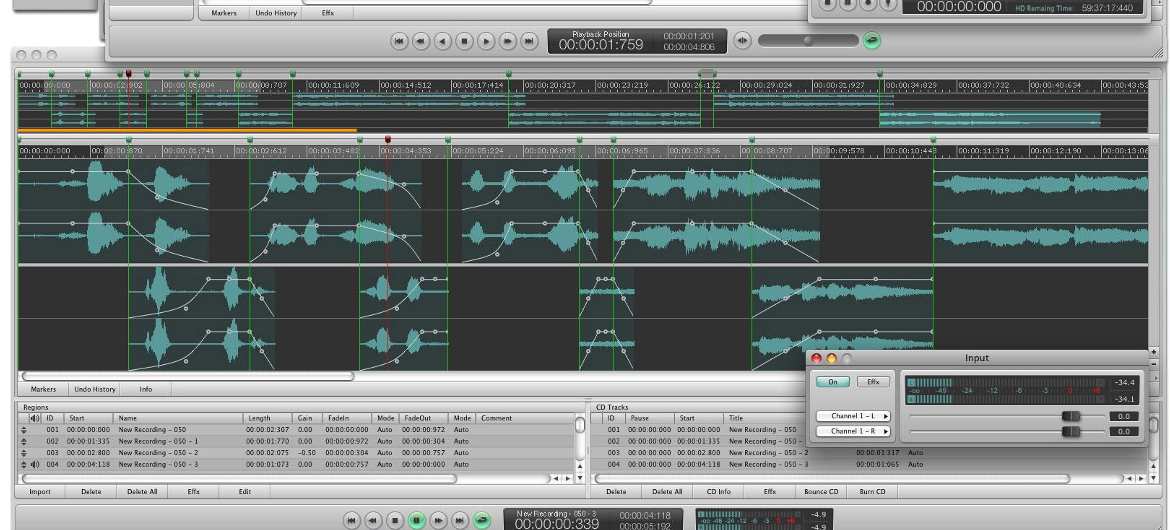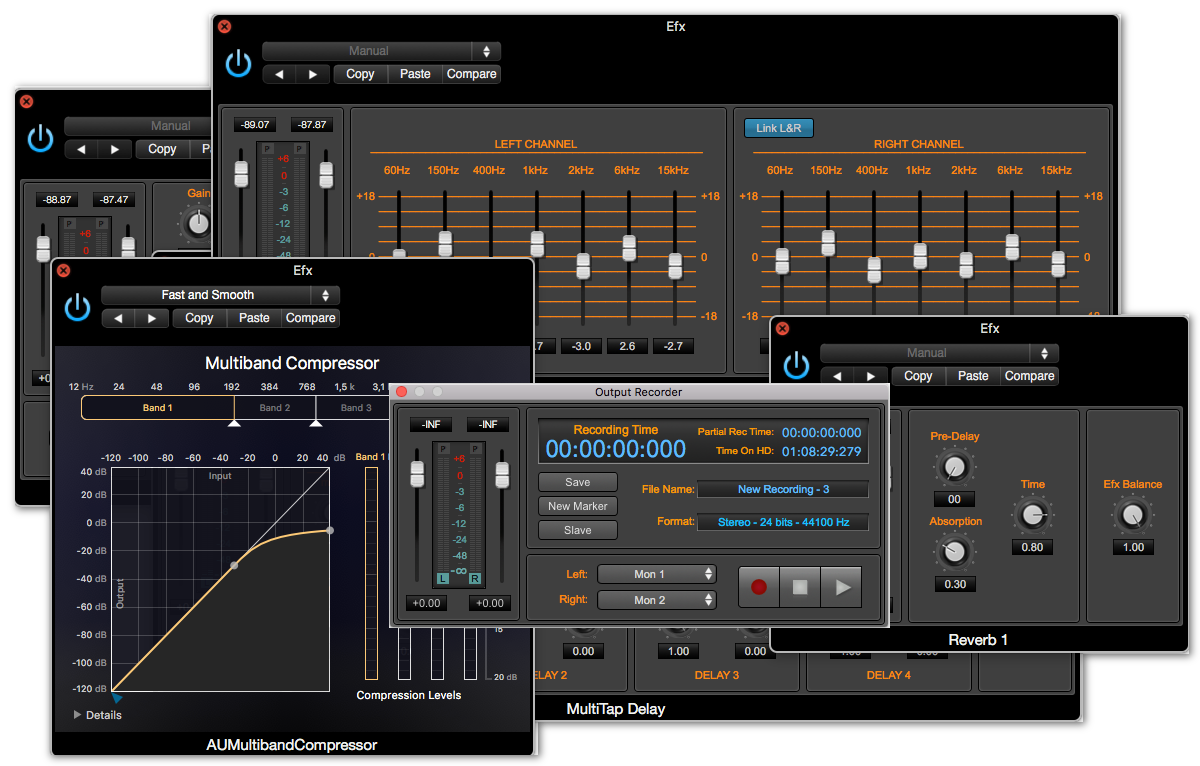Mar 08, 2005 DSP Quattro is a two track editor with audio recording and Audio Unit hosting capabilities. The only thing I'm not sure if it can do quickly you listed is cut up a piece of audio by marker, though it does have markers. DSP Quattro inherits an updated version of the loop-editing window found in D‑Sound Pro, which I always considered one of that program's most useful features. It offers a clear and easy-to-understand representation of the loop points in a sample, with the left-hand side of the window showing the waveform immediately before the loop end,. Professional Audio Editor. DSP-Quattro 5 is the complete solution for Audio Editing, AudioCD Mastering and Plug-in Hosting for the MacOS X. DSP-Quattro is an extremely powerful Audio Editor/AudioCD Mastering Application with extended real-time and off-line support of AU/VST plug-ins for MacOS X.
Current limiting is the practice of imposing a limit on the current that may be delivered to a load to protect the circuit generating or transmitting the current from harmful effects due to a short-circuit or overload. The term 'current limiting' is also used to define a type of overcurrent protective device. According to the 2020 NEC/NFPA 70, current limiting overcurrent protective device is defined as, 'A device that, when interrupting currents in its current-limiting range, reduces the current flowing in the faulted circuit to a magnitude substantially less than that obtainable in the same circuit if the device were replaced with a solid conductor having compatible impedance.'
Inrush current limiting[edit]
An inrush current limiter is a device or group of devices used to limit inrush current. Passive resistive components such as resistors or negative temperature coefficient (NTC) thermistors are simple options, with power dissipation and cool-down time being their main drawbacks, respectively. More complex solutions using active components can be used when simpler options are unsuitable.

In electronic power circuits[edit]
Some electronic circuits employ active current limiting, since a fuse may not protect solid-state devices.
One style of current limiting circuit is shown in the image. The schematic is representative of a simple protection mechanism used in regulated DC supplies and class-AB power amplifiers.
Q1 is the pass or output transistor. Rsens is the load current sensing device. Q2 is the protection transistor which turns on as soon as the voltage across Rsens becomes about 0.65 V. This voltage is determined by the value of Rsens and the load current through it (Iload). When Q2 turns on, it removes base current from Q1 thereby reducing the collector current of Q1. which is very nearly the load current. Thus, Rsens fixes the maximum current to a value given by 0.65/Rsens. For example, if Rsens = 0.33 Ω, the current is limited to about 2 A even if Rload becomes a short (and Vo becomes zero).
Further, this power dissipation will remain as long as the overload exists, which means that the devices must be capable of withstanding it for a substantial period. This power dissipation will be substantially less than if no current limiting circuit had been provided. In this technique, beyond the current limit the output voltage will decrease to a value depending on the current limit and load resistance.
To reduce the heat that must be dissipated by the pass devices under a short-circuit, foldback current limiting is used, which reduces current in the short-circuit case. Under a short circuit, where the output voltage has reduced to zero, the current is typically limited to a small fraction of the maximum current.
The prime purpose of foldback current limiting in linear power supplies is to keep the output transistor within its safe power dissipation limit. A linear regulator dissipates the difference between input and output voltages as heat. Under overload conditions the output voltage falls and so the difference becomes larger, thus increasing dissipation. Foldback helps to keep the output transistor within its safe operating area under fault and overload conditions. Foldback also significantly reduces the power dissipation in the load in fault conditions, which can reduce the risks of fire and heat damage.[1]
Many power supplies employ constant current limiting protection; foldback goes one step further by reducing the output current limit linearly as output voltage decreases. However it adds complexity to the power supply and can trigger 'lockout' conditions with non-ohmic devices that draw a constant current independent of supply voltage (such as op-amps). A foldback current limiter may also employ a transient delay to both avoid lockout and limit localized heating at the short circuit.
A switched-mode power supply operating at the current limit with the output short circuited does not have increased power dissipation in the power transistor(s), so foldback current limiting is an application feature only rather than one that also prevents a load fault from also destroying the power supply. The safety benefit of reducing the power delivered to a short circuit in the load is proportional to the operating current limit. Foldback current limiting is most likely to be found in a switchmode power supply when it is a component in a product that is independently certified to meet regional safety standards. [2]
Single power-supply circuits[edit]

Dsp Sound System
An issue with the previous circuit is that Q1 will not be saturated unless its base is biased about 0.5 volts above Vcc.
These circuits operate more efficiently from a single (Vcc) supply. In both circuits, R1 allows Q1 to turn on and pass voltage and current to the load. When the current through R_sense exceeds the design limit, Q2 begins to turn on, which in turn begins to turn off Q1, thus limiting the load current. The optional component R2 protects Q2 in the event of a short-circuited load. When Vcc is at least a few volts, a MOSFET can be used for Q1 for lower dropout voltage. Due to its simplicity, this circuit is sometimes used as a current source for high-power LEDs.[3]
See also[edit]
References[edit]
- ^ Paul Horowitz, Winfield Hill, The Art of Electronics Second Edition, Cambridge University Press, 1989 ISBN0-521-37095-7, p.316
- ^Keith H. Billings (1999). Switchmode power supply handbook. McGraw-Hill Professional. p. 1.113. ISBN978-0-07-006719-6.
- ^'The New Stuff!!! Constant Current Source #1'. Instructables. Retrieved 4 July 2012.CS1 maint: discouraged parameter (link)
External links[edit]

Download DSP-Quattro 5 for Mac full version program setup free. The DSP-Quattro is a comprehensive, yet easy to use application that includes extended real-time and off-line capabilities for AU/VST plugins.
DSP-Quattro 5 Review

DSP-Quattro is a software utility developed specifically to master audio file and audio CD editing. It is the most complete tool in the market that will prove useful for the most advanced graphical sample-based waveform editing. The program comes with a clean and user-friendly interface that makes the audio editing more interesting and engaging. Using its advanced tools, you can perform sample-based editing such as Frequency Shifting algorithms, phase-locked Time Stretching, and linear phase Sample Rate Converting. You may also like Thenatan Underwater FX for Mac Free Download DSP-Quattro allows you to perform editing to 64-bit Audio Units. Moreover, it contains an advanced looping tool that assists you to build sample libraries.
Its Declicking algorithm gives you complete control to perform vinyl restoration effortlessly. You can also burn audio CD-ROMs, import and export DDP files quickly. The application provides support for PQ subcodes, CD-Texts, EAN, UPC, ISRC, and ID3 Tags. It empowers you to write on disc all the tracks that you have listened to in real-time. DSP-Quattro offers virtual instruments that help in live performance. The bottom line is that DSP-Quattro is an imposing application to master audio files in a unique and most interesting way.
Quattro Usb Audio Interface Driver
Features of DSP-Quattro 5
- An impressive tool to master audio file and audio CD editing
- Provides built-in tools such as 64-bit audio and graphic engines
- Offers advanced looping tools that allow you to build sample libraries
- Enables you to burn CD-ROMs and import and export DDP files
- Provides support for PQ subcodes, CD-Texts, EAN, UPC, ISRC, and ID3 Tags
Technical Details of DSP-Quattro 5 for Mac
- Software Name: DSP-Quattro 5
- Software File Name: DSP-Quattro-5.5.1.dmg
- File Size: 46 MB
- Developers: Dsp-Quattro
System Requirements for DSP-Quattro 5 for Mac
- macOS 10.11 or later
- 200 MB free HDD
- 1 GB RAM
- 64-bit Intel processor
DSP-Quattro 5 Free Download
Click on the button given below to download DSP-Quattro 5 free setup. It is a complete offline setup of DSP-Quattro 5 for macOS with a single click download link.
